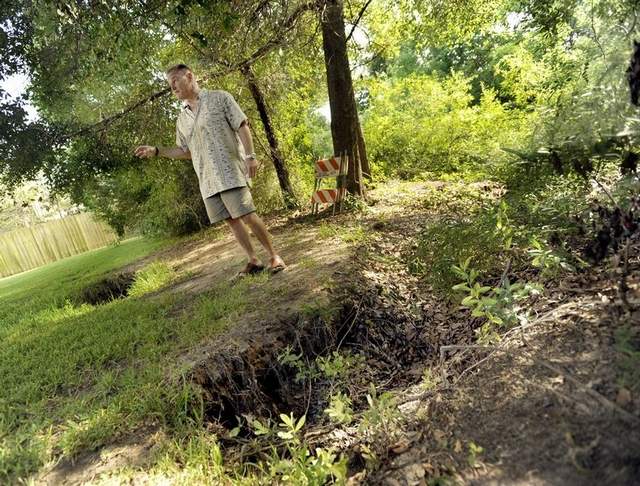
For seven years, Leanne Pickering has watched as erosion and sinkholes expanded in the backyard of her Pensacola home, and she now wonders when they will overtake her swimming pool.
They are getting close; a 5-foot-deep sinkhole currently is within 6 feet of her pool's enclosure.
In 2002, Pickering built her home in a Creek Side Circle neighborhood near Airport Boulevard and Davis Highway that backs up to Carpenter's Creek.
Before long, she noticed her backyard was steadily falling into the creek. She found soft spots in the grass. Sinkholes began to form. Every year for the last five years, she has paid to have a truckload of dirt dumped into the largest hole. The hole continues to grow.
"I have had three sinkholes pop up in the last year that have crept up into our yard. I am losing considerable amounts of soil," said Chad Swan, Pickering's live-in boyfriend.
Swan, a 46-year-old officer in the U.S. Marines, believes the City of Pensacola should stabilize the creek bank with rip-rap rock, a rock commonly used to slow erosion.
"The creek is the city's responsibility, and I don't have the time or funds available to rent or contract out a bunch of heavy equipment to do it myself," Swan said.
But city Public Works Director Al Garza says erosion control on private property is not the city's responsibility. The city is responsible for stormwater management of the creek, specifically to try to reduce the volume of water flowing into it, and to improve the quality of the water.
City Councilwoman Sherri Myers, whose district includes the creek, has asked city staff to look into the problem, but she says there is no easy answer.
"I have a lot of sympathy for the property owners, for their yards to be eroding away like they are, but we have to be careful that we do the right thing for the creek and everyone who lives downstream," she said. "It is a very complicated problem."
Flowing downstream
Five miles downstream from Pickering and Swan, other residents have complained to Myers not about sinkholes or erosion, but just the opposite: excessive sediment buildup in the creek, and where the creek dumps into Bayou Texar. Some of the sediment is from the yards of residents like Pickering and Swan.
While erosion and sediment buildup are natural occurrences for any creek, some residents believe the level of both seems to have grown in recent decades as development grew along the creek.
"If you build a house on a creek and there's massive clear cutting going on around you, we can't go back and fix it for you," said Myers, who lives about a quarter of a mile from the creek.
Swan and Pickering's neighbors on each side are seeing the same signs in their backyards.
Though the holes in Les and Linda Austin's yard are less noticeable than in Swan and Pickering's yard, the Austins, too, have seen some of their landscaping fall into sinkholes.
Swan and Pickering have had countless experts examine the situation during the past three years and give varying advice, but they still don't know for sure what's causing the sinkholes.
In some places the grass has died because the soil underneath has fallen away from the roots.
Swan said a private geological expert told him it was likely a subterranean erosion issue: water flowing underground hits a clay hardpan, diverting the water to other areas, and causing tunneling underground that seeps out of the banks of the creek and erodes away the soil.
The expert said the more the bank erodes, the more it can create a stronger siphoning effect underneath the subsurface level that compounds the problem.
"Groundwater flow tends to follow the natural typography; all of that is a natural process," said Garza, who has been in touch with Swan about the issue since March 2010.
No easy fixes
One expert had advised Swan to address the problem by having a $40,000 seawall built along the back of his yard.
He was considering it when he got a second opinion from another expert who advised against it because it would multiply the erosion effect for neighbors on either side of him and then they may sue him.
Shortly after taking office, Myers asked the city's Environmental Advisory Board to study the issues with the creek. The committee eventually is expected to give a report on the creek to the council. In the meantime, Myers is not rushing to judgment on how to address it.
"Frankly, my primary concern is the creek itself," Myers said. "I have to leave those decisions, on what should be done, to the experts. And I am not the expert. Mr. Garza is.
"But I do know that whenever you remove trees it impacts the ground. Since I had to have trees taken out that fell after Hurricane Ivan, I have sinkholes all over my property."



Reader Comments
to our Newsletter